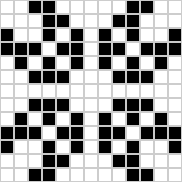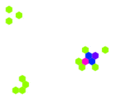Conway's Game of Life facts for kids
The Game of Life is an imaginary robot game (cellular automaton) made by the British mathematician John Horton Conway in 1970.
The reason it is called a game is because people who play the game can set it up in different ways to make it do different things. Sometimes people play the game by changing the way the imaginary robot is set up at the start to watch what happens. The Game of Life is a zero-player game because it changes without anybody playing (after the starting position is chosen). A different type of game lets two players set up imaginary robots to see which one is better.
Rules
The game is played on a grid of squares called cells, each cell is black (alive) or white (dead). When people are playing the game, they start by making some dead cells alive. Then the alive cells can make other cells alive or dead because of the rules of the game. The rules are:
- Any alive cell that is touching less than two alive neighbours dies.
- Any alive cell touching four or more alive neighbours dies.
- Any alive cell touching two or three alive neighbours does nothing.
- Any dead cell touching exactly three alive neighbours becomes alive.
The way a player sets up the first alive cells starts the game. The first level (generation) is made by using the 4 rules. After the player is done changing the cells, they do the same thing all over again to make the next level. The game is over when all the cells are dead or all the cells are alive or the game is doing the same thing over and over. The Game of Life is Turing-complete.
History
John Horton Conway made the Game of Life because he wanted to know if he could make an imaginary robot out of cells that would be able to get bigger. He combined lots of ideas in math to make the rules for the game. It is one of the first ever 'simulation games' which are games that represent things that happen in real life. It is important because when used in complicated math, it can look at many things like physics, biology, economics, and philosophy.
Patterns
Patterns are special things that happen in the game. Many different types of patterns happen, including static patterns where nothing changes between levels, repeating patterns where the cells that are alive and dead repeat, and patterns that move themselves across the board ("spaceships"). Common examples of these three classes are shown below, with live cells shown in black, and dead cells shown in white.
| |
|
|
|
|
 |
 |
| Block | Boat | Blinker | Toad | Glider | LWSS | Pulsar |
The "block" and "boat" do not change, the "blinker" and "toad" have 2 looks that repeat, and the "glider" and "lightweight spaceship" ("LWSS") are spaceships which keep moving across the cells in each level. The "pulsar" [1] is the most common repeat that has 3 parts. Most of the repeating patterns have 2 parts, like the blinker and toad.
Variations on Life
Since the Game of Life was made, some people play with new rules. These rules are usually more ways to make cells alive or dead, or they are more rules to make it harder for cells to switch.
Some variations change the way the cells look or where they are put.
Two players
When two people play the Game of Life, the alive cells have two colors and a player wins when their colors take up all of the cells. When a dead cell becomes alive, its color is the same as the alive cells that touch it. If both colors are touching the new alive cell, then the color that touches it more wins.
Images for kids
-
The 6366548773467669985195496000th (6×1027) generation of a Turing machine, made in the game of Life, computed in less than 30 seconds on an Intel Core Duo 2 GHz CPU using Golly in Hashlife mode
See also
 In Spanish: Juego de la vida para niños
In Spanish: Juego de la vida para niños








